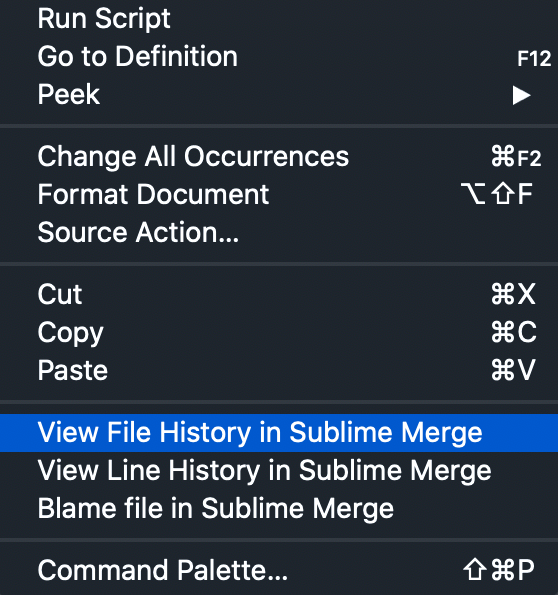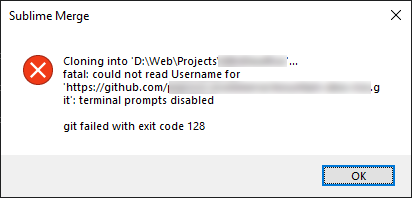

- #Sublime merge clond repository how to#
- #Sublime merge clond repository software#
- #Sublime merge clond repository code#
After the in the Source URL, add newusername where newusername is your new GitHub username. In the section labeled Source URL, paste the URL as shown in the above screenshot you shared. clone that repository locally using command line git: git clone git-userremoteserver:repo-name add files and just run Sublime Merge. /t/how-do-i-add-a-second-user/56265ĝon’t worry about the previous steps - try the following: Open Sublime Merge and navigate to the clone page. In the field below, specify the folder to create the repository in. This is my workflow: create the new empty repository on the remote server, by command line. By this, the branch being merged is not affected. When we perform merging, git always merges with the current branch from where we are performing the operation (in our case it is main).
I wanted to create a bug report on their issue tracker, but the problems are too intermittent, erratic, and. A git merge operation is performed by running the command git mergeSome time starting maybe in the last 1-3 months, Ive noticed it has been very unreliable. With this option, you can have folders of your project under control of different version control systems. Sublime Merge has been unreliable lately Ive been happily using Sublime Merge as a licensed user since it first came out.
#Sublime merge clond repository code#
See the git error message "git failed with exit code 128" pop up Select this option to have a repository initialized in one of the folders below the project root.Click on "Clone" (the source URL and the repository path should be filled in correctly beforehand).

#Sublime merge clond repository software#
Compare price, features, and reviews of the software side-by-side to make the best choice for your business. Copy the SSH or HTTPS command for cloning a BitBucket repository into the clipboard Sublime Merge using this comparison chart.Working with the repository in Sublime Merge after having cloned it via the shell works like a charm. My public SSH key is part of the repository config at BitBucket.

When I issue the exact same commands from the command line of my Bash shell, everything works like a charm. You just need to add a flag to the `ls` command that will ask it to show hidden folders, and that’s the `-laf` flag.Not 100% sure whether this is a bug related to Sublime Merge, but: When I try to clone any BitBucket repository using either SSH ( git clone or HTTPS ( git clone with Sublime Merge (I created a publicly accessible repository, so you can use the actual links I mention here), it fails with the error message popup saying: With a bit of magic, though, we can see it ourselves. That period in front of the `.git` folder means that it’s actually a hidden folder, so it won’t show up in your Finder or Explorer window and is typically only meant for scripts and OS-level commands to access. If `ls` and seeing your project’s folders isn’t enough for you, there’s another technique to be even more sure that you’re in the right place. Whereas GitLab’s import tool imports a GitHub repository including its pull requests, issues, wikis, and other data, GitHub’s importer only imports the bare-bones Git. Alternatively, you can rename a local branch by running the following commands: git checkout master. Because many repositories belonged to single developers, only a few repositories contained merge requests (and issues). When you’ve selected the right branch, follow these steps: Using the Git branch command, add an -m option to your line: git branch -m new-name. The other way is to initialize a new Git repository using the `git init` command to set up version tracking in a new folder.Įither way, that `.git` folder I mentioned should exist in the repository’s root (top-most folder). Moving Merge Requests and Issues from GitLab to GitHub.

One way is to run the `git clone` command and clone a repository from an existing repository (whether that repository exists locally on your computer or on a server running Git such as ). Generally speaking, you can get a Git repository locally in one of two ways. modify, merge, publish, distribute, sublicense, and/or sell copies of the Software, and. Alternatively, to accept the local version for all conflicting files, use: git merge -strategy-option ours.
To accept all changes on a file from the local version, run: git checkout -ours#Sublime merge clond repository how to#
How to really know you’re in a Git repository With Git: Clone the repository to the Sublime Text 'Packages' directory. There are three ways to resolve a merge conflict in Git: 1.


 0 kommentar(er)
0 kommentar(er)
